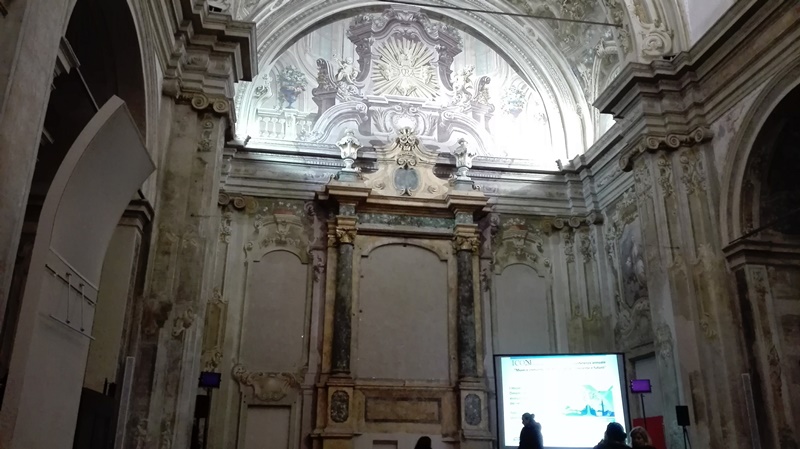This week, I attended ICOM Italy’s conference, “The role of local and regional museums in the building of a people’s Europe” in Bologna. The event, as the title suggests, focused on the role of small and regional museums, not just in the fabric of nations, but also their role in the wider European landscape – and, we may say, the world. Indeed, ICOM Director General Peter Keller bluntly said that in this period of disunity – with Brexit looming and Catalonian independence coming to the fore – the cross-border role of museums becomes even more crucial.
Day 1 – morning session
The role of local and regional museums in the building of a people’s Europe
The opening remarks from Alberto Garlandini highlighted the importance of museums to work together towards common aims. As Vice-President of ICOM, Garlandini obviously stressed his organisation’s role in helping to protect cultural heritage through international and inter-institutional cooperation. The dangers facing cultural artefacts – for example, in conflict zones – often do not pay attention to national boundaries and can be too large for single entities to face alone. ICOM and other associations can help museums, institutions and governments to collectively protect our most vulnerable cultural heritage.

Moving on to museums, Roberto Balzani reminded us that they are both sites and collections. While the former are “monads”, the latter are “nomads” moving within and between institutions. Balzani is the President of the Institute of Cultural Heritage for the Region of Emilia Romagna, and also serves as a professor at the University of Bologna. He briefly explained how the historical citing of museums have changed them. Frequently, national museums started as physical buildings, to which various objects migrated, forming vast collections. This was then followed by a period of diversification, where national institutes were devolved to house fine art, for example, separate from natural history. As the role of institutions have changed, so have the meanings of the objects. Is an object to be researched, learned from, displayed in the public collection, or simply protected? Sometimes we move objects to new locations in order to preserve them – how does that change their meaning?
Coming back to the role of rural museums, Pietro Clemente from the Italian Society for Museum and Heritage Anthropology (SIMBDEA), said that Italy is a country of a thousand cities and a thousand regional museums. Although they are small and diverse, these institutions can be vital in areas which are seeing rapid depopulation. In Armungia, for example, the population has declined to less than 500 inhabitants, and has been losing a net of ten citizens every year for the past decade. Yet it is home to three small but popular museums. The village of Cocullo – with only 250 inhabitants – welcomes thousands of visitors every May for its Snake Festival, while in Monticchiello, all 200 residents are members of the town’s ‘poor’ theatre.

Continuing on this theme, Daniele Jalla from ICOM Italy said that local museums are bricks in the building of the national museums. Additionally, they bring the idea of the nation to the local level. Whereas state museums are specialised, local ones must be encyclopaedic. Although Jalla called himself a provocateur, his ideas might not seem so radical outside of Italy. He suggests that large collections can be a burden, and wonders if conservation should be separated from display. Some collections simply have no audience, and may be of interest only to the most ardent researchers.
Finally, rounding out the Italian perspective, Frabrizio Arosio from Italy’s department of statistics (ISTAT) gave a very detailed quantitative analysis of civic museums throughout Italy’s regions. If I understood correctly (simultaneous translation has its drawbacks!), civic museums make up three-quarters of all public museums in Italy, and in some regions they outnumber cinemas. Italy has experienced a massive expansion of civic museums since 1975 when it had just 532, to 2015 with 1900 museums. This is in part because of a change in understanding of what a museum could be. Convents, old factories, and agricultural centres have become sites for civic museums and ethnographic education. This is in stark contrast to state museums which tend to focus on art and archaeology. Also, because civic museums are situated within communities, they have a strong emphasis on events and temporary exhibitions. And of course, because they are so small – many have fewer than 1000 visitors a year – different museums will work together to create networks and pool resources. This could be in the form of combined ticketing, or the loaning of objects, for example. An interesting note is that these museums have a smaller percentage of foreign visitors than the national average, and the age of visitors tends to skew older.
All in all, a very interesting discussion about the diverse small museums in Italy – civic, regional and local – and the roles they play within the broader network of the country’s cultural institutions.

